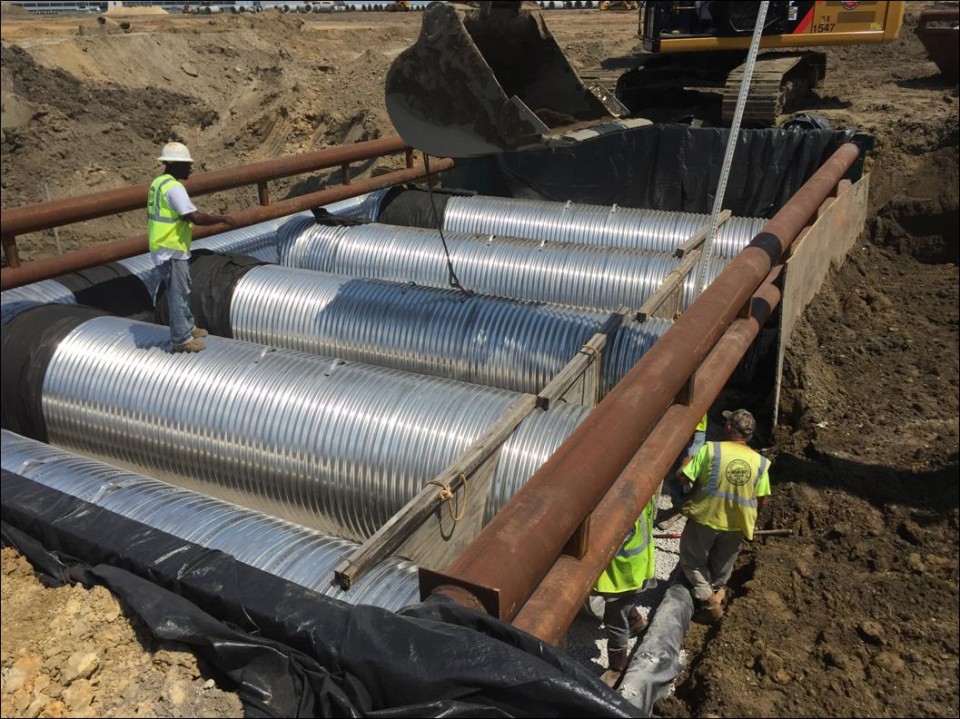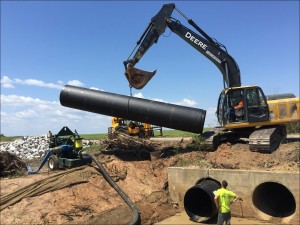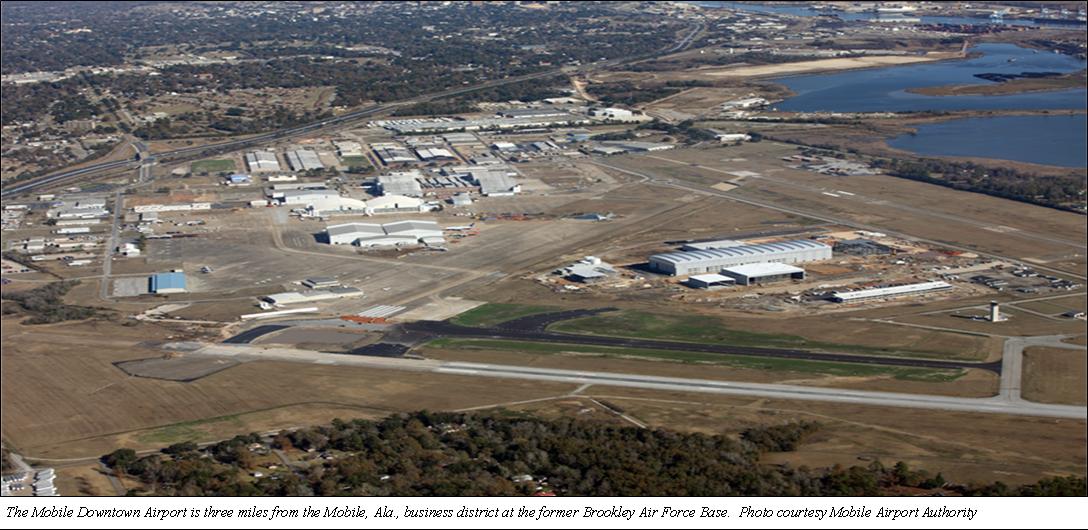Mobile downtown airport expects to get busy
- January 2, 2016
- / Ron Stallcup
- / economy

From college football team charters to military C-130s, the Mobile Downtown Airport is hardly all Airbus, all the time.
Granted, the assembly plant for the A320 series jetliners draws most of the attention as the star tenant of the Mobile Aeroplex at Brookley, once a World War II Air Force base known as Brookley Field. It’s also true that the Mobile Airport Authority is doing $39 million in construction work in large part because of the 210,000-square-foot Airbus Manufacturing Facility.
But military air traffic still makes up half of the “operations” or take-offs and landings, at the airport on Mobile Bay, said Roger Wehner, executive director of the authority. That may well change as Airbus reaches full capacity and support businesses move in.
“We used to have about 100,000 operations a year. That was almost evenly divided between 50,000 military training activity and 50,000 business jet, general aviation and MAE, Continental Motors,” Wehner said.
“I’ve got a Coast Guard helicopter flying overhead right now. Yesterday we had a C-130 flying in and out. Because of the preponderance of military installations on the Gulf Coast, we get a lot of military traffic.”
However, overall air traffic is down slightly this year, Wehner said. He attributes the decline to the airport’s biggest current project, a $32 million two-phase realignment, lengthening and widening of the main Taxiway A. The work is expected to be finished in 2016 after being on the drawing board for several years.
“I would say that the Airbus project has kind of sped that along, because the taxiway used to go through the Airbus site. So they’ll certainly be a beneficiary, but it wasn’t the No. 1 cause agent. It’s always been on the books,” Wehner said.
Signature Flight Support, the fixed based operator at the downtown airport (FAA ID BFM), has seen a similar decline in traffic, said station manager Matt Thocker.
“We get a lot of our business from the military flights and training flights,” Thocker said. “They’ve actually been down a little bit. We think most of that’s been due to the taxiway being reworked and upgraded. Up to this point it’s been slightly down, but we’re expecting a growth spurt probably next year.”
Signature bought out Azalea Aviation, owned by Taylor and Harris Morrisette, in 2012 about six months ahead of the official Airbus announcement.
The sale anticipated that Airbus would locate its first U.S. final assembly plant in Mobile, but Thocker said the company also thought the airport was growth-oriented anyway, aside from the Airbus plant.
Signature Flight Support is owned by BBA Aviation and is the world’s largest FBO network. Signature will expand further as a result of BBA’s acquisition of Landmark Aviation for more than $2 billion.
Because of FAA regulations, the British-owned FBO cannot operate its own planes, Thocker said. Signature has three hangars, provides fuel for FedEx and MAE in addition to general aviation customers, and provides multiple passenger services ranging from baggage handling to hotel reservations to catering services.
About 30 percent of Signature’s business is military, Thocker said. The FBO also handles football team charters for the University of South Alabama, its opponents and the GoDaddy Bowl. BFM is much closer to Ladd-Peebles Stadium, where the bowl and USA games are played, than is Mobile Regional Airport, and Signature can easily transfer player luggage to downtown hotels.
The airport’s other two construction projects are about to get started: a $6 million engine run-up facility and a $1 million compass compensation area. An engine run-up facility is where plane engines are tested without flying. The aircraft can “run up” the engine to full speed and power back down to ensure everything is working properly.
A compass compensation area is where new or refurbished magnetic compass systems used in navigation are calibrated. The area must be meticulously surveyed for magnetic distortion, Wehner said.
Both existing facilities were displaced by Airbus, requiring the new construction. Airbus will be a major customer.
“You take advantage of the opportunity to make it far better,” Wehner said.
Arguably the biggest asset of Mobile Downtown airport is its two runways that are long enough to handle any size aircraft in the world. The plane ferrying the space shuttle cross country once stopped to refuel at BFM. The runways are 9,618 feet long and 7,800 feet long. They are 150 feet wide.
The airport boasts easy access to water and rail transportation. The aeroplex is adjacent to the Port of Mobile, which was one of the key attractions for Airbus. Airbus ships planes in pieces to the port and trucks them the short distance to its assembly plant.
Once Airbus is at full capacity and the construction is out of the way, Wehner said air traffic will go up.
“I doubt we will get a significant increase on military traffic, but I’m confident that we’ll have an increase on commercial and business jets,” he said.
More good news may be coming, too. Wehner hopes to “have clarity” in the next six months on at least a couple of economic development projects.
“We’re competing right now for several projects, just pure economic development projects,” he said. “Any one of them, if we were to win it, would have a significant impact on the facility.”
Gulf_Coast_Aerospace_Corridor.com is a website created in 2008 to highlight aerospace activities along the Interstate 10 corridor between New Orleans and Northwest Florida. It includes reference material, job postings, a daily aerospace newsfeed and weekly column. In 2011, the website teamed with several journalists to create the Gulf Coast Reporters’ League, which writes and publishes an annual book about aerospace in the region. The first book was published in June 2011. In September 2013, the League launched an eight-page quarterly aerospace newsletter, which became a bimonthly in August 2014 after the League published the fourth edition of the annual.
All the books can be found at: www.gulfcoastaerospacecorridor.com/gcacbooksall.html;
and all the newsletters can be found at www.gulfcoastaerospacecorridor.com/gcacnewslettersall.html.


 CivicCon launches with a look at good growth in cities
CivicCon launches with a look at good growth in cities
 Building stronger brains one baby, one parent at a time
Building stronger brains one baby, one parent at a time
 SCI debuts commercial on Early Learning City
SCI debuts commercial on Early Learning City
 Entrecon: World class speakers and an opportunity to sharpen skills
Entrecon: World class speakers and an opportunity to sharpen skills
 PYP Quality of Life survey 2017
PYP Quality of Life survey 2017
 EntreCon Pensacola 2016: A look back
EntreCon Pensacola 2016: A look back
 Leadership tip: getting better employee takeaways
Leadership tip: getting better employee takeaways
 Leadership tip: be interested instead of interesting
Leadership tip: be interested instead of interesting
 Leadership tip: delivering difficult messages
Leadership tip: delivering difficult messages
 Brain Bags boost Arc, Early Childhood Court programs
Brain Bags boost Arc, Early Childhood Court programs